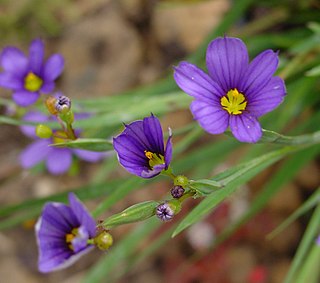
Sisyrinchium is a large genus of annual to perennial flowering plants in the family Iridaceae. Native to the New World, the species are known as blue-eyed grasses. Although they are not true grasses (Poaceae), they are monocots.
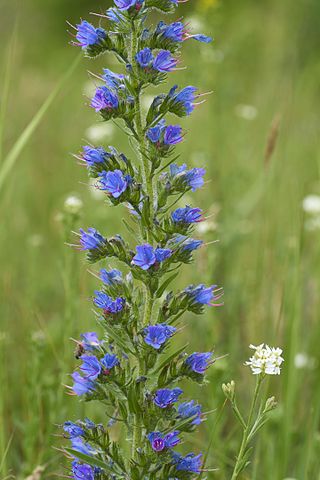
Echium vulgare, known as viper's bugloss and blueweed, is a species of flowering plant in the borage family Boraginaceae. It is native to most of Europe and western and central Asia and it occurs as an introduced species in north-eastern North America, south-western South America and the South and North Island of New Zealand. The plant root was used in ancient times as a treatment for snake or viper bites. If eaten, the plant is toxic to horses and cattle through the accumulation of pyrrolizidine alkaloids in the liver.
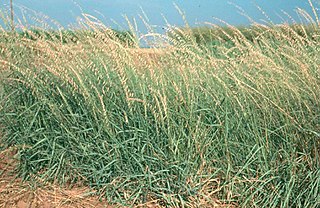
Bouteloua curtipendula, commonly known as sideoats grama, is a perennial, short prairie grass that is native throughout the temperate and tropical Western Hemisphere, from Canada south to Argentina.

Baptisia australis, commonly known as blue wild indigo or blue false indigo, is a flowering plant in the family Fabaceae (legumes). It is a perennial herb native to much of central and eastern North America and is particularly common in the Midwest, but it has also been introduced well beyond its natural range. Naturally it can be found growing wild at the borders of woods, along streams or in open meadows. It often has difficulty seeding itself in its native areas due to parasitic weevils that enter the seed pods, making the number of viable seeds very low. The plant has low toxicity levels for humans.

Olsynium douglasii is a species of flowering plant in the iris family (Iridaceae). Common names include Douglas' olsynium, Douglas' grasswidow, grass-widow, blue-eyed grass, purple-eyed-grass, and satin flower, It is the only species in the genus Olsynium in North America, the remaining 11 species being from South America. It was formerly treated in the related genus Sisyrinchium. Despite the common names, it is not a true grass (Poaceae).

Sisyrinchium montanum, the blue-eyed-grass, American blue-eyed-grass, or strict blue-eyed grass, is a grass-like species of plant from the genus Sisyrinchium, native to northern North America from Newfoundland west to easternmost Alaska, and south to Pennsylvania in the east, and to New Mexico in the Rocky Mountains. It has also been introduced to parts of France, likely during the First World War.

Bossiaea walkeri, commonly known as cactus bossiaea, cactus pea, or Walker's stick bush, is a species of flowering plant in the pea family (Fabaceae) and is endemic to southern mainland Australia. It is a rigid, much-branched shrub with flattened, winged cladodes and red, pea-like flowers between July and November in the species' native range.
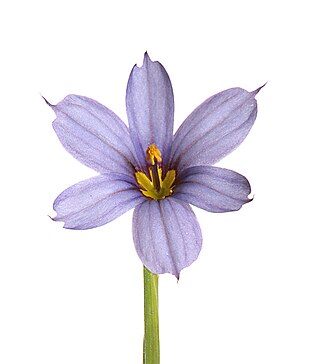
Sisyrinchium angustifolium, commonly known as narrow-leaf blue-eyed-grass, is a herbaceous perennial growing from rhizomes, native to moist meadow and open woodland. It is the most common blue-eyed grass of the eastern United States, and is also cultivated as an ornamental.

Sisyrinchium pruinosum, the dotted blue-eyed grass, is a perennial plant in the family Iridaceae, native to the south-central United States. There are also reports of the plant in California, but these appear to represent naturalizations. It is sometimes considered to be a synonym of Sisyrinchium langloisii.
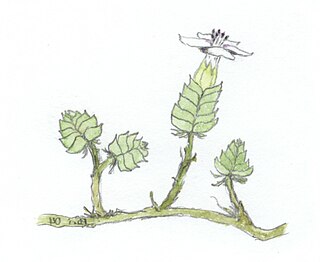
Wilsonia humilis, the silky wilsonia, is a species of perennial subshrub in the family Convolvulaceae. The species is endemic to Australia, occurring in coastal saltmarshes and also occasionally in inland saline areas, often colonising bare ground.

Melaleuca phoenicea, commonly known as scarlet bottlebrush or lesser bottlebrush, is a plant in the myrtle family, Myrtaceae and is endemic to the south-west of Western Australia. The Noongar peoples know the plant as tubada. It is a shrub with thick, blue-green leaves and spikes of scarlet bottlebrush flowers in spring and summer.
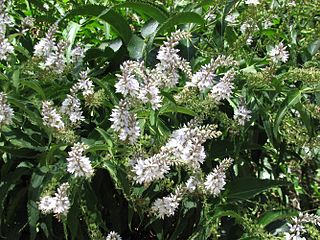
Veronica derwentiana, commonly known as Derwent speedwell, is a flowering plant species of the family Plantaginaceae, endemic to south-eastern Australia. It is a perennial with toothed leaves and white or pale blue flowers in terminal sprays in spring and summer.

Sisyrinchium californicum is a species of flowering plant in the iris family known by the common names golden blue-eyed grass, yellow-eyed-grass, and golden-eyed-grass. It is native to the west coast of North America from British Columbia to central California, where it grows in moist habitat, often in coastal areas.

Sisyrinchium dichotomum is a rare species of flowering plant in the iris family known by the common names wishbone blue-eyed grass, white irisette, and reflexed blue-eyed grass. It is native to North Carolina and South Carolina in the United States, where fewer than ten populations remain in four counties. It is threatened by the loss and degradation of its habitat and is a federally listed endangered species of the United States.
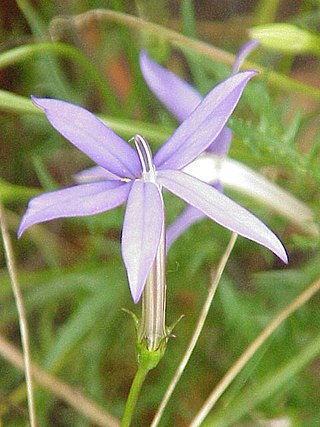
Isotoma axillaris, commonly known as rock isotome or showy isotome, is a small herbaceous perennial in the family Campanulaceae. It usually has blue or mauve star-shaped flowers from September to May. It may also be called blue star, star flower, or laurentia.
Sisyrinchium sarmentosum is a species of flowering plant in the iris family known by the common names mountain blue-eyed grass and pale blue-eyed-grass. It is native to the Pacific Northwest of North America, where it is known from a part of the Cascade Mountains in Washington and Oregon.

Sisyrinchium bermudiana, known as Bermudiana or, along with other members of the genus, as blue-eyed grass, is a flower of the genus Sisyrinchium that is native to the Atlantic archipelago, and British Overseas Territory, of Bermuda and the island of Ireland. The plant appears and blooms in the spring. It has been used as a totemic flower by Bermudians, and appears in art, jewellery, banknotes and elsewhere.

Sisyrinchium campestre, the prairie blue-eyed grass or white-eyed grass, is a small herbaceous perennial plant in the iris family, native to prairie and meadow in the central United States and in extreme southern Manitoba.
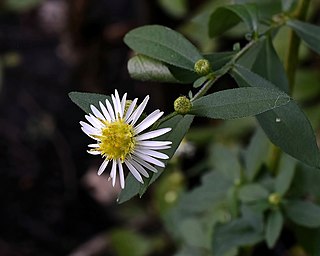
Symphyotrichum ontarionis is a species of flowering plant in the family Asteraceae native to eastern North America. Commonly known as Ontario aster and bottomland aster, it is a perennial, herbaceous plant that may reach heights of 120 centimeters. Each flower head has many tiny florets put together into what appear as one.
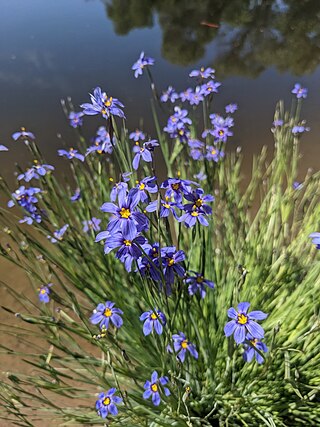
Sisyrinchium demissum, commonly called stiff blue-eyed grass is small member of the iris family in genus Sisyrinchium. The plant's natural range is in the western United states and northern Mexico. It is sometimes grown in garden settings in its native range.



















